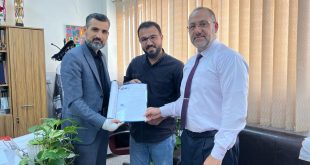Assistant Professor Nadir Mustafa Nanakali from the Department of General Biology at Cihan University-Erbil. Published a research article entitled “Enzyme immobilization onto the nanomaterials: Application in enzyme stability and prodrug-activated cancer therapy” in the International Journal of Biological Macromolecules.
About the author:
Name: Nadir Mustafa Nanakali
Qualification: Ph.D.
Academic rank: Assistant Professor
Affiliation: Department of General Biology, Cihan University-Erbil
TAP: https://academics.su.edu.krd/nadir.nanakali
Google Scholar account: https://scholar.google.com/citations?user=1tUZJ6wAAAAJ&hl=en
Journal Coverage:
Title:International Journal of Biological Macromolecules
Science Citation Index
Science Citation Index Expanded
Clarivate Analytics (Wos: IF = 4.784)
SCOPUS: Q1
Publisher: Elsevier
Country: Netherland
About the Paper:
Title: Enzyme immobilization onto the nanomaterials: Application in enzyme stability and prodrug-activated cancer therapy.
DOI: https://doi.org/10.1016/j.ijbiomac.2019.12.064
Abstract:
Nanoparticles (NPs) have been widely used for immobilization of wide ranges of enzymes. However, the stabilization of enzymes on NPs is a major challenge, crucial for regulating enzymatic activity and their medical applications. To overcome these challenges, it is necessary to explore how enzymes attach to nanomaterials and their properties are affected by such interactions. In this review we present an overview on the different strategies of the enzyme immobilization into the NPs and their corresponding stability against temperature and pH. The effects of surface charge, particle size, morphology, and aggregation of NPs on the stability of immobilized enzymes were summarized. The activity of immobilized enzyme into the NPs was reviewed to disclose more detail regarding the interaction of biomolecules with NPs. The combination of enzyme immobilization with prodrugs was also reviewed as a promising approach for biomedical application of enzyme in cancer therapy. Finally, the current challenges and future applications of NPs in enzyme immobilization and the utilization of immobilized enzyme toward prodrug activation in cytoplasm of cancer cells were presented. In conclusion, this review may pave the way for providing a perspective on development to the industrial and clinical translation of immobilized enzymes.

 Quality Assurance Cihan University – Erbil
Quality Assurance Cihan University – Erbil



